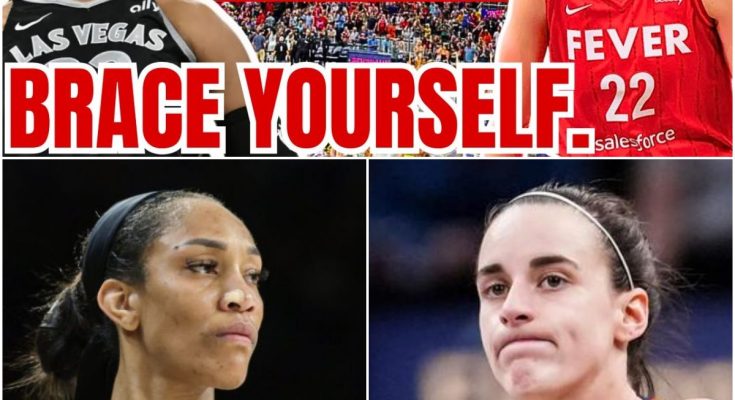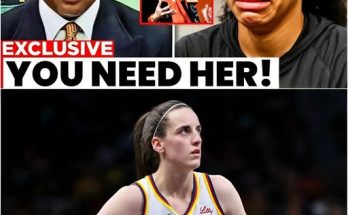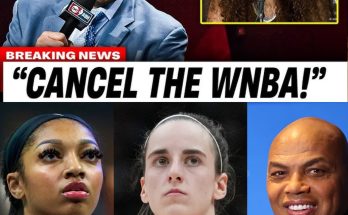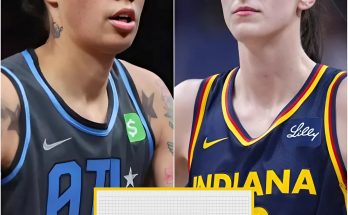The WNBA has always dreamed of a breakthrough moment—a player capable of drawing millions of eyes, selling out arenas, and pushing women’s basketball to the center of the national conversation. In 2024, that dream became reality with the arrival of Caitlin Clark, a generational talent whose presence has transformed the league’s fortunes overnight. But as Clark’s star has risen, so too has the scrutiny on the league’s officiating, culminating in a scandal that now threatens to undermine everything the WNBA has worked for.
A Storm Brewing
For weeks, fans and analysts have watched in disbelief as Clark, the Indiana Fever’s rookie phenom, has faced relentless physical play on the court. Game after game, she’s been grabbed, pushed, and pressured—often with little intervention from referees. The breaking point came during a high-stakes matchup between the Fever and the New York Liberty, a game that would expose the league’s officiating crisis for all to see.
With just seconds left and the Fever trailing by two, Clark took the ball, poised for a signature clutch moment. Instead, she was met with obvious contact—multiple defenders grabbing and applying pressure—yet the referees swallowed their whistles. The replay left no doubt: Clark was fouled, but no call came. Fans erupted in outrage, social media exploded, and analysts called it a “masterclass in how not to officiate basketball.”
But it wasn’t just one play. In the game’s final moments, the officials missed three crucial calls, including a phantom foul that handed the Liberty game-winning free throws. Fever coach Stephanie White, usually measured, stormed into the post-game press conference and called out a “minus-31 free throw discrepancy” over recent games. “The disrespect right now for our team has been pretty unbelievable,” she said, voicing what millions had witnessed.
The Injury That Changed Everything
As the controversy swirled, the Fever dropped a bombshell: Caitlin Clark would miss at least two weeks with a left quadriceps strain, ending an eight-year streak of never missing a game. The injury, which Clark had reportedly played through for weeks, sent shockwaves through the league—not just for its impact on the court, but for what it revealed about the WNBA’s priorities.
Footage soon emerged of Clark using heat packs on her leg during games, fans reported seeing her in obvious discomfort, and speculation mounted that the league’s failure to protect its biggest star had led directly to her sidelining. Suddenly, the WNBA was facing not just a player safety crisis, but a financial one
The Numbers Don’t Lie
The economic fallout was immediate. Clark’s games had been averaging over 1.1 million viewers; without her, viewership plummeted by 42%. Ticket prices for marquee matchups collapsed overnight. Indianapolis hotels, which had seen a boom in bookings tied to Fever home games, braced for a downturn. Even the Fever’s $75 million practice facility, greenlit because of Clark’s drawing power, suddenly seemed a risky bet.
Perhaps most telling were the betting markets: Clark’s MVP odds tumbled, and analysts began openly wondering if the WNBA could sustain its newfound relevance without her. ESPN had broadcast a Fever preseason game for the first time ever, drawing numbers usually reserved for NBA stars like LeBron James. Now, the league faced the prospect of returning to obscurity.
The Referee Reckoning
Under mounting pressure, the WNBA finally acted. In a quiet Tuesday morning press release, the league announced the suspension of three referees for their roles in recent officiating controversies. There was no press conference, no apology to Clark or the Fever—just a terse statement that officials had been “relieved of their duties pending further review.”
For many, the move was too little, too late. Insiders revealed that the league had access to damning footage for weeks, showing Clark being targeted with little protection. Yet action only came when the financial impact became impossible to ignore. The three suspended refs, critics say, are scapegoats for a deeper, systemic problem—one rooted in the league’s own competition committee.
Who’s Really in Charge?
According to a revealing SB Nation article, the WNBA’s competition committee—made up of stakeholders, coaches, governors, and general managers—dictates the style of play and the level of physicality allowed. Referees, in turn, are expected to follow these directives, receiving feedback not from fans or players, but from stakeholders whose primary concern is revenue and storylines.
Former NBA referee Mick McCutchen explained that officials are often promoted rapidly, sometimes moving from high school gyms to the professional ranks in a matter of years. One of the suspended officials had primarily high school experience before being upgraded to the WNBA. This, critics argue, is a recipe for disaster—especially in a league that now finds itself under the harshest spotlight in its history.
A League at a Crossroads
The WNBA’s handling of the Clark crisis has become a case study in how not to manage a superstar. For years, the league begged for mainstream attention. Now, with Clark delivering LeBron-level viewership, it allowed her to be targeted until injury forced her off the court. The result? Ratings tanked, fan outrage soared, and the league’s credibility is on the line.
The upcoming games will be a harsh reality check. The Fever’s anticipated rematch with the Chicago Sky, once a ratings bonanza, will now feature Angel Reese against Fever role players while Clark recovers. The league must now decide: will it finally prioritize player safety and fair officiating, or continue to chase short-term storylines at the expense of its future?
The Real Lesson
The suspension of three referees may quiet some critics, but true accountability will require more. The WNBA must confront uncomfortable truths about its officiating system, its stakeholder-driven priorities, and its willingness to protect its stars. If not, it risks losing not just Caitlin Clark, but the entire wave of new fans she brought to the game.
As the league stands at this crossroads, one thing is clear: the world is watching. The next move could define the WNBA for years to come.
What do you think? Are the suspensions enough, or does the WNBA need a complete overhaul? Drop your thoughts below.



